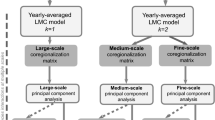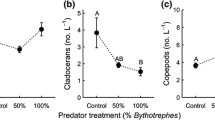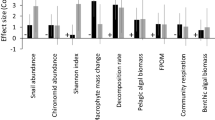Abstract
Temporal patterns of interspecific interactions and their correspondence with life history events are of key significance for community dynamics, but often overlooked in characterising the mechanisms of species invasions and predicting competitive outcomes. Here, we examine the role of seasonality in moderating interactions between a globally important invasive mysid shrimp (Hemimysis anomala) and an ecologically similar native species (Mysis salemaai) by combining distribution and diet surveys with experimental quantification of comparative resource exploitation rates and mutual aggressive interactions. We found partial overlap in winter, but not summer horizontal distributions of the two species. Diets were highly similar in the seasonally overlapping range, potentially resulting in competition for the high-quality, but seasonally scarce, zooplankton prey in invaded lakes. Despite its smaller size, H. anomala had similar feeding rates to M. salemaai on three key zooplankton prey species. H. anomala was more aggressive toward M. salemaai than M. salemaai was toward H. anomala, although there was no evidence for intraguild predation. Our findings indicate that spatio-temporal niche partitioning permitted invasion by H. anomala and coexistence with M. salemaai, in spite of their high trophic similarity.





Similar content being viewed by others
References
Barrios-O’Neill, D., J. T. A. Dick, M. C. Emmerson, A. Ricciardi, H. J. MacIsaac, M. E. Alexander & H. C. Bovy, 2014b. Fortune favours the bold: a higher predator reduces the impact of a native but not an invasive intermediate predator. Journal of Animal Ecology 83: 693–701.
Barrios-O’Neill, D., J. T. A. Dick, A. Ricciardi, H. J. MacIsaac & M. C. Emmerson, 2014a. Deep impact: in situ functional responses reveal context-dependent interactions between vertically migrating invasive and native mesopredators and shared prey. Freshwater Biology 59: 2194–2203.
Bates, D., M. Mächler, B. Bolker & S. Walker, 2015. Fitting linear mixed-effects models using lme4. Journal of Statistical Software 67: 1–48.
Berlow, E. L., 1999. Strong effects of weak interactions in ecological communities. Nature 398: 330–334.
Blenckner, T., R. Adrian, D. M. Livingstone, E. Jennings, G. A. Weyhenmeyer, D. G. George, T. Jankowski, M. Järvinen, C. N. Aonghusa, T. Nõges, D. Straile & K. Teubner, 2007. Large-scale climatic signatures in lakes across Europe: a meta-analysis. Global Change Biology 13: 1314–1326.
Burlakova, L. E., A. Y. Karatayev & D. K. Padilla, 2000. The impact of Dreissena polymorpha (Pallas) invasion on unionid bivalves. International Review of Hydrobiology 85: 529–541.
CaraDonna, P. J., W. K. Petry, R. M. Brennan, J. L. Cunningham, J. L. Bronstein, N. M. Waser & N. J. Sanders, 2017. Interaction rewiring and the rapid turnover of plant-pollinator networks. Ecology Letters 20: 385–394.
Caroni, R. & K. Irvine, 2010. The potential of zooplankton communities for ecological assessment of lakes: redundant concept or political oversight? Biology and Environment: Proceedings of the Royal Irish Academy 110B: 35–53.
Chapple, D. G., S. M. Simmonds & B. B. M. Wong, 2012. Can behavioral and personality traits influence the success of unintentional species introductions? Trends in Ecology and Evolution 27: 57–64.
Clarke, K. R., 1993. Non-parametric multivariate analyses of changes in community structure. Australian Journal of Ecology 18: 117–143.
Clarke, K. & R. Gorley, 2006. PRIMER v6: user manual/tutorial. PRIMER-E, Plymouth.
Cuddington, K. & A. Hastings, 2016. Autocorrelated environmental variation and the establishment of invasive species. Oikos 125: 1027–1034.
Davis, M. A., J. P. Grime & K. Thompson, 2000. Fluctuating resources in plant communities: a general theory of invasibility. Journal of Ecology 88: 528–534.
Dick, J. T. A., K. Gallagher, S. Avlijas, H. C. Clarke, S. E. Lewis, S. Leung, D. Minchin, J. Caffrey, M. E. Alexander, C. Maguire, C. Harrod, N. Reid, N. R. Haddaway, K. D. Farnsworth, M. Penk & A. Ricciardi, 2013. Ecological impacts of an invasive predator explained and predicted by comparative functional responses. Biological Invasions 15: 837–846.
Dingle, H., 2014. Migration: The Biology of Life on the Move. Oxford University Press, Oxford.
Donohue, I., H. Hillebrand, J. M. Montoya, O. L. Petchey, S. L. Pimm, M. S. Fowler, K. Healy, A. L. Jackson, M. Lurgi, D. McClean, N. E. O’Connor, E. J. O’Gorman & Q. Yang, 2016. Navigating the complexity of ecological stability. Ecology Letters 19: 1072–1085.
Donohue, I., O. Petchey, S. Kéfi, A. Génin, A. Jackson, Q. Yang & N. E. O’Connor, 2017. Loss of predator species, not intermediate consumers, triggers rapid and dramatic extinction cascades. Global Change Biology 23: 2962–2972.
Downing, A. S., E. H. van Nes, J. H. Janse, F. Witte, I. J. M. Cornelissen, M. Scheffer & W. M. Mooij, 2012. Collapse and reorganization of a food web of Mwanza Gulf, Lake Victoria. Ecological Applications 22: 229–239.
Eccard, J. A., K. Fey, B. A. Caspers & H. Ylonen, 2011. Breeding state and season affect interspecific interaction types: indirect resource competition and direct interference. Oecologia 167: 623–633.
Gallagher, K., R. Rosell, L. Vaughan, Y. R. McElarney, W. Campbell, E. O’Kane & C. Harrod, 2015. Hemimysis anomala G.O. Sars, 1907 expands its invasive range to Northern Ireland. BioInvasions Records 4: 43–46.
Gallardo, B., M. Clavero, M. I. Sánchez & M. Vilà, 2016. Global ecological impacts of invasive species in aquatic ecosystems. Global Change Biology 22: 151–163.
García Molinos, J. & I. Donohue, 2011. Temporal variability within disturbance events regulates their effects on natural communities. Oecologia 166: 795–806.
García Molinos, J., M. Viana, M. Brennan & I. Donohue, 2015. Importance of Long-Term Cycles for Predicting Water Level Dynamics in Natural Lakes. PLOS ONE 10: e0119253.
Gaston, K., J. Duffy, S. Gaston, J. Bennie & T. Davies, 2014. Human alteration of natural light cycles: causes and ecological consequences. Oecologia 176: 917–931.
González-Moreno, P., J. M. Diez, I. Ibáñez, X. Font & M. Vilà, 2014. Plant invasions are context-dependent: multiscale effects of climate, human activity and habitat. Diversity and Distributions 20: 720–731.
Griffiths, D., K. A. Macintosh, E. Forasacco, B. Rippey, L. Vaughan, Y. R. McElarney & K. Gallagher, 2015. Mysis salemaai in Ireland: new occurrences and existing population declines. Biology and Environment: Proceedings of the Royal Irish Academy 115B: 1–7.
Grosholz, E. D., 2005. Recent biological invasion may hasten invasional meltdown by accelerating historical introductions. Proceedings of the National Academy of Sciences of the United States of America 102: 1088–1091.
Hansson, L. A. & S. Åkesson, 2014. Animal Movement Across Scales. Oxford University Press, Oxford.
Hayes, K. & S. Barry, 2008. Are there any consistent predictors of invasion success? Biological Invasions 10: 483–506.
Human, K. G. & D. M. Gordon, 1996. Exploitation and interference competition between the invasive Argentine ant, Linepithema humile, and native ant species. Oecologia 105: 405–412.
Iacarella, J. C., J. T. A. Dick & A. Ricciardi, 2015a. A spatio-temporal contrast of the predatory impact of an invasive freshwater crustacean. Diversity and Distributions 21: 803–812.
Iacarella, J. C., J. T. A. Dick, M. E. Alexander & A. Ricciardi, 2015b. Ecological impacts of invasive alien species along temperature gradients: testing the role of environmental matching. Ecological Applications 25: 706–716.
Jackson, M. C. & J. Grey, 2013. Accelerating rates of freshwater invasions in the catchment of the River Thames. Biological Invasions 15: 945–951.
Jackson, M. C., I. Donohue, A. L. Jackson, J. R. Britton, D. M. Harper & J. Grey, 2012. Population-level metrics of trophic structure based on stable isotopes and their application to invasion ecology. PLoS ONE 7: e31757.
Jackson, M. C., J. Grey, K. Miller, J. R. Britton & I. Donohue, 2016. Dietary niche constriction when invaders meet natives: evidence from freshwater decapods. Journal of Animal Ecology 85: 1098–1107.
Kumschick, S., M. Gaertner, M. Vilà, F. Essl, J. M. Jeschke, P. Pyšek, A. Ricciardi, S. Bacher, T. M. Blackburn, J. T. A. Dick, T. Evans, P. E. Hulme, I. Kühn, A. Mrugała, J. Pergl, W. Rabitsch, D. M. Richardson, A. Sendek & M. Winter, 2015. Ecological impacts of alien species: quantification, scope, caveats, and recommendations. Bioscience 65: 55–63.
Kumschick, S. & D. M. Richardson, 2013. Species-based risk assessments for biological invasions: advances and challenges. Diversity and Distributions 19: 1095–1105.
Kuznetsova, A., P. Brockhoff & R. Christensen, 2017. lmerTest package: tests in linear mixed effects models. Journal of Statistical Software 67: 1–48.
Larsen, L. O. & S. Dufour, 1993. Growth, reproduction and death in lampreys and eels. In Rankin, J. C. & F. B. Jensen (eds), Fish Ecophysiology. Springer, Dordrecht: 72–104.
Li, W. & M. H. H. Stevens, 2012. Fluctuating resource availability increases invasibility in microbial microcosms. Oikos 121: 435–441.
Lopez, D. P., A. A. Jungman & J. S. Rehage, 2012. Nonnative African jewelfish are more fit but not bolder at the invasion front: a trait comparison across an Everglades range expansion. Biological Invasions 14: 2159–2174.
McKeon, C. S., M. X. Weber, S. E. Alter, N. E. Seavy, E. D. Crandall, D. J. Barshis, E. D. Fechter-Leggett & K. L. L. Oleson, 2016. Melting barriers to faunal exchange across ocean basins. Global Change Biology 22: 465–473.
McMeans, B. C., K. S. McCann, M. Humphries, N. Rooney & A. T. Fisk, 2015. Food web structure in temporally-forced ecosystems. Trends in Ecology & Evolution 30: 662–672.
Minchin, D. & R. Boelens, 2010. Hemimysis anomala is established in the Shannon River Basin District in Ireland. Aquatic Invasions 5: S71–S78.
Monceau, K., J. Moreau, J. Poidatz, O. Bonnard & D. Thiéry, 2015. Behavioral syndrome in a native and an invasive hymenoptera species. Insect Science 22: 541–548.
Morgan, M. D. & S. T. Threlkeld, 1982. Size dependent horizontal migration of Mysis relicta. Hydrobiologia 93: 63–68.
Mrowicki, R. J., N. E. O’Connor & I. Donohue, 2016. Temporal variability of a single population can determine the vulnerability of communities to perturbations. Journal of Ecology 104: 887–897.
Muller, A. C. & D. L. Muller, 2015. Forecasting future estuarine hypoxia using a wavelet based neural network model. Ocean Modelling 96: 314–323.
Norton, W. H. J., K. Stumpenhorst, T. Faus-Kessler, A. Folchert, N. Rohner, M. P. Harris, J. Callebert & L. Bally-Cuif, 2011. Modulation of Fgfr1a signaling in zebrafish reveals a genetic basis for the aggression-boldness syndrome. The Journal of Neuroscience 31: 13796–13807.
Olden, J. D., N. L. Poff, M. R. Douglas, M. E. Douglas & K. D. Fausch, 2004. Ecological and evolutionary consequences of biotic homogenization. Trends in Ecology and Evolution 19: 18–24.
O’Connor, N. E., M. E. S. Bracken, T. P. Crowe & I. Donohue, 2015. Nutrient enrichment alters the consequences of species loss. Journal of Ecology 103: 862–870.
O’Connor, N. E., M. Emmerson, T. Crowe & I. Donohue, 2013. Distinguishing between direct and indirect effects of predators in complex ecosystems. Journal of Animal Ecology 82: 438–448.
Penk, M. R. & D. Minchin, 2014. Seasonal migration of a glacial relict mysid into the littoral zone and its co-occurrence with an introduced competitor. Hydrobiologia 726: 1–11.
Penk, M., K. Irvine & I. Donohue, 2015. Ecosystem-level effects of a globally spreading invertebrate invader are not moderated by a functionally similar native. Journal of Animal Ecology 84: 1628–1636.
Penk, M. R., J. M. Jeschke, D. Minchin & I. Donohue, 2016a. Warming can enhance invasion success through asymmetries in energetic performance. Journal of Animal Ecology 85: 419–426.
Penk, M., I. Donohue, D. Minchin & K. Irvine, 2016b. Life history timing, but not body size, of Mysis salemaai (Crustacea: Mysida) conserved across a trophic gradient at its southern distribution. Hydrobiologia 775: 83–95.
Penk, M., W.-C. Saul, J. T. A. Dick, I. Donohue, M. E. Alexander, S. Linzmaier & J. M. Jeschke, 2017. A trophic interaction framework for identifying the invasive capacity of novel organisms. Methods in Ecology and Evolution 8: 1786–1794.
Petchey, O. L., U. Brose & B. C. Rall, 2010. Predicting the effects of temperature on food web connectance. Philosophical Transactions of the Royal Society B: Biological Sciences 365: 2081–2091.
Pintor, L. M., A. Sih & M. L. Bauer, 2008. Differences in aggression, activity and boldness between native and introduced populations of an invasive crayfish. Oikos 117: 1629–1636.
R Core Team, 2016. R: a language and environment for statistical computing. In: R Foundation for Statistical Computing. http://www.R-project.org.
Reynolds, J. B. & G. M. DeGraeve, 1972. Seasonal population characteristics of the opossum shrimp, Mysis relicta, in southeastern Lake Michigan, 1970–71. Proceedings of the 15th Conference on Great Lakes Research: 117–131.
Ricciardi, A., S. Avlijas & J. Marty, 2012. Forecasting the ecological impacts of the Hemimysis anomala invasion in North America: lessons from other freshwater mysid introductions. Journal of Great Lake Research 38: 7–13.
van Riel, M. C., G. van der Velde & A. B. de Vaate, 2009. Interference competition between alien invasive gammaridean species. Biological Invasions 11: 2119–2132.
Samhouri, J. F., R. R. Vance, G. E. Forrester & M. A. Steele, 2009. Musical chairs mortality functions: density-dependent deaths caused by competition for unguarded refuges. Oecologia 160: 257–265.
Sih, A., A. Bell & J. C. Johnson, 2004a. Behavioral syndromes: an ecological and evolutionary overview. Trends in Ecology and Evolution 19: 372–378.
Sih, A., A. M. Bell, J. C. Johnson & R. E. Ziemba, 2004b. Behavioral syndromes: an integrative overview. Quarterly Review of Biology 79: 241–277.
Simberloff, D., 2009. The role of propagule pressure in biological invasions. Annual Review of Ecology Evolution and Systematics 40: 81–102.
Simberloff, D., 2011. How common are invasion-induced ecosystem impacts? Biological Invasions 13: 1255–1268.
Simberloff, D., J.-L. Martin, P. Genovesi, V. Maris, D. A. Wardle, J. Aronson, F. Courchamp, B. Galil, E. García-Berthou, M. Pascal, P. Pyšek, R. Sousa, E. Tabacchi & M. Vilà, 2013. Impacts of biological invasions: what’s what and the way forward. Trends in Ecology and Evolution 28: 58–66.
Strayer, D. L., C. M. D’Antonio, F. Essl, M. S. Fowler, J. Geist, S. Hilt, I. Jarić, K. Jöhnk, C. G. Jones, X. Lambin, A. W. Latzka, J. Pergl, P. Pyšek, P. Robertson, M. Schmalensee, R. A. Stefansson, J. Wright & J. M. Jeschke, 2017. Boom-bust dynamics in biological invasions: towards an improved application of the concept. Ecology Letters 20: 1337–1350.
Strayer, D. L. & H. M. Malcom, 2007. Effects of zebra mussels (Dreissena polymorpha) on native bivalves: the beginning of the end or the end of the beginning? Journal of the North American Benthological Society 26: 111–122.
Suraci, J. P., M. Clinchy, L. M. Dill, D. Roberts & L. Y. Zanette, 2016. Fear of large carnivores causes a trophic cascade. Nature Communications 7: 7.
Terborgh, J. & J. A. Estes, 2010. Trophic Cascades: Predators, Prey, and the Changing Dynamics of Nature. Island Press, Washington.
Therneau, T., 2015. A package for survival analysis in S. version 2.38. https://CRAN.R-project.org/package=survival.
Urban, M. C., 2007. Predator size and phenology shape prey survival in temporary ponds. Oecologia 154: 571–580.
Vitousek, P. M., C. M. Dantonio, L. L. Loope & R. Westbrooks, 1996. Biological invasions as global environmental change. American Scientist 84: 468–478.
Väinölä, R. & J. K. Vainio, 1998. Distributions, life cycles and hybridization of two Mysis relicta group species (Crustacea: Mysida) in the northern Baltic Sea and Lake Baven. Hydrobiologia 368: 137–148.
Walton, Z., J. Mattisson, J. D. C. Linnell, A. Stien & J. Odden, 2017. The cost of migratory prey: seasonal changes in semi-domestic reindeer distribution influences breeding success of Eurasian lynx in northern Norway. Oikos 126: 642–650.
Werner, E. E. & D. J. Hall, 1977. Competition and habitat shift in two sunfishes (Centrarchidae). Ecology 58: 869–876.
Winder, M. & J. E. Cloern, 2010. The annual cycles of phytoplankton biomass. Philosophical Transactions of the Royal Society B: Biological Sciences 365: 3215–3226.
Wollrab, S., A. M. de Roos & S. Diehl, 2013. Ontogenetic diet shifts promote predator-mediated coexistence. Ecology 94: 2886–2897.
Acknowledgements
We thank Magda Gluza and Tomek Piątek for help in the field. This work was supported by the Irish Research Council in partnership with Ecological Consultancy Services Limited (ECS/2009/01).
Author information
Authors and Affiliations
Corresponding author
Ethics declarations
Conflict of interest
The authors declare that they have no conflict of interest.
Additional information
Handling editor: Gideon Gal
Electronic supplementary material
Below is the link to the electronic supplementary material.
Rights and permissions
About this article
Cite this article
Penk, M.R., Donohue, I. & Irvine, K. Temporally variable niche overlap and competitive potential of an introduced and a native mysid shrimp. Hydrobiologia 823, 109–119 (2018). https://doi.org/10.1007/s10750-018-3700-2
Received:
Revised:
Accepted:
Published:
Issue Date:
DOI: https://doi.org/10.1007/s10750-018-3700-2




